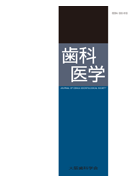Volume 55, Issue 1
Displaying 1-28 of 28 articles from this issue
- |<
- <
- 1
- >
- >|
-
Article type: Article
1992 Volume 55 Issue 1 Pages 1-18
Published: February 25, 1992
Released on J-STAGE: February 27, 2017
Download PDF (1855K) -
Article type: Article
1992 Volume 55 Issue 1 Pages 19-36
Published: February 25, 1992
Released on J-STAGE: February 27, 2017
Download PDF (1924K) -
Article type: Article
1992 Volume 55 Issue 1 Pages 37-53
Published: February 25, 1992
Released on J-STAGE: February 27, 2017
Download PDF (1518K) -
Article type: Article
1992 Volume 55 Issue 1 Pages 54-71
Published: February 25, 1992
Released on J-STAGE: February 27, 2017
Download PDF (1805K) -
Article type: Article
1992 Volume 55 Issue 1 Pages 72-81
Published: February 25, 1992
Released on J-STAGE: February 27, 2017
Download PDF (917K)
-
Article type: Article
1992 Volume 55 Issue 1 Pages 82-83
Published: February 25, 1992
Released on J-STAGE: February 27, 2017
Download PDF (291K) -
Article type: Article
1992 Volume 55 Issue 1 Pages 83-84
Published: February 25, 1992
Released on J-STAGE: February 27, 2017
Download PDF (298K) -
Use of the rolling and scrubbing methods by the elderly and ways of elevating brushing effectivenessArticle type: Article
1992 Volume 55 Issue 1 Pages 84-85
Published: February 25, 1992
Released on J-STAGE: February 27, 2017
Download PDF (285K) -
Article type: Article
1992 Volume 55 Issue 1 Pages 85-86
Published: February 25, 1992
Released on J-STAGE: February 27, 2017
Download PDF (286K) -
Article type: Article
1992 Volume 55 Issue 1 Pages 86-87
Published: February 25, 1992
Released on J-STAGE: February 27, 2017
Download PDF (284K) -
Article type: Article
1992 Volume 55 Issue 1 Pages 87-88
Published: February 25, 1992
Released on J-STAGE: February 27, 2017
Download PDF (290K) -
Article type: Article
1992 Volume 55 Issue 1 Pages 88-89
Published: February 25, 1992
Released on J-STAGE: February 27, 2017
Download PDF (284K) -
Article type: Article
1992 Volume 55 Issue 1 Pages 90-
Published: February 25, 1992
Released on J-STAGE: February 27, 2017
Download PDF (199K) -
Article type: Article
1992 Volume 55 Issue 1 Pages 91-92
Published: February 25, 1992
Released on J-STAGE: February 27, 2017
Download PDF (316K) -
Article type: Article
1992 Volume 55 Issue 1 Pages 92-93
Published: February 25, 1992
Released on J-STAGE: February 27, 2017
Download PDF (288K) -
Article type: Article
1992 Volume 55 Issue 1 Pages 93-94
Published: February 25, 1992
Released on J-STAGE: February 27, 2017
Download PDF (301K) -
Article type: Article
1992 Volume 55 Issue 1 Pages 94-95
Published: February 25, 1992
Released on J-STAGE: February 27, 2017
Download PDF (316K) -
Article type: Article
1992 Volume 55 Issue 1 Pages 95-96
Published: February 25, 1992
Released on J-STAGE: February 27, 2017
Download PDF (272K) -
Article type: Article
1992 Volume 55 Issue 1 Pages 97-98
Published: February 25, 1992
Released on J-STAGE: February 27, 2017
Download PDF (306K) -
Article type: Article
1992 Volume 55 Issue 1 Pages 98-99
Published: February 25, 1992
Released on J-STAGE: February 27, 2017
Download PDF (304K) -
Article type: Article
1992 Volume 55 Issue 1 Pages 99-100
Published: February 25, 1992
Released on J-STAGE: February 27, 2017
Download PDF (299K) -
Article type: Article
1992 Volume 55 Issue 1 Pages 100-101
Published: February 25, 1992
Released on J-STAGE: February 27, 2017
Download PDF (278K) -
Article type: Article
1992 Volume 55 Issue 1 Pages 101-102
Published: February 25, 1992
Released on J-STAGE: February 27, 2017
Download PDF (257K) -
Article type: Article
1992 Volume 55 Issue 1 Pages 103-104
Published: February 25, 1992
Released on J-STAGE: February 27, 2017
Download PDF (281K) -
Article type: Article
1992 Volume 55 Issue 1 Pages 104-105
Published: February 25, 1992
Released on J-STAGE: February 27, 2017
Download PDF (276K) -
Article type: Article
1992 Volume 55 Issue 1 Pages 105-106
Published: February 25, 1992
Released on J-STAGE: February 27, 2017
Download PDF (202K)
-
Article type: Article
1992 Volume 55 Issue 1 Pages g51-g52
Published: February 25, 1992
Released on J-STAGE: February 27, 2017
Download PDF (269K) -
Article type: Article
1992 Volume 55 Issue 1 Pages g53-g54
Published: February 25, 1992
Released on J-STAGE: February 27, 2017
Download PDF (218K)
- |<
- <
- 1
- >
- >|
